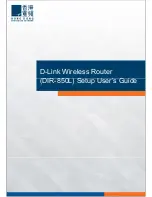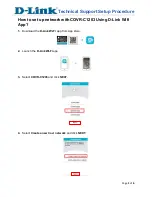
108 © 2001- 2008 D-Link Corporation. All Rights Reserved.
D-Link Unified Access System User Manual
Channel
The
Channel
defines the portion of the radio spectrum that the radio uses for
transmitting and receiving. The range of channels and the default channel are
determined by the Mode of the radio interface and the country in which the
APs operate.
In the United States, IEEE 802.11b/802.11g modes (802.11 b/g) support use
of channels 1 through 11 inclusive, while IEEE 802.11a mode supports a
larger set of non-consecutive channels (36,40,44, 48, 52, 56, 60, 64, 149,
153, 157, 161, 165).
Interference can occur when multiple access points within range of each
other are broadcasting on the same or overlapping channels. The impact of
this interference on network performance can intensify during busy times
when a large amount of data and media traffic is competing for bandwidth.
If you select auto, the AP scans the RF area for occupied channels and selects
a channel from the available non-interfering, or clear channels. The AP
selects the best channel whenever its radio or radios restart.
If you specify a channel, make sure that the channel does not interfere with
the channel that neighbor APs use.
NOTE: The channel you set for an AP in the valid AP database is fixed and
takes precedence over initial channel selection done by the AP and any
automatic channel planning done by the switch.
NOTE: For radios that use 802.11a mode, some countries have a regulatory
domain that requires radar detection. For these countries (based on the
country code setting), the radio automatically uses the 802.11h protocol for
selecting the channel if radar is detected on the statically assigned channel.
Power
The power level affects how far an AP broadcasts its RF signal. If the power
level is too low, wireless clients will not detect the signal or experience poor
WLAN performance. If the power level is too high, the RF signal might
interfere with other APs within range.
The default value of 0 indicates that the AP uses the power level set in the AP
profile.
NOTE: The power level you set for an AP in the valid AP database is fixed
and takes precedence over any automatic power adjustments done by the AP
or the switch.
Table 16.
Valid AP Configuration
Field
Description
Summary of Contents for DWS-3024L
Page 8: ...D Link Unified Access System User Manual ...
Page 12: ...12 2001 2008 D Link Corporation All Rights Reserved D Link Unified Access System User Manual ...
Page 20: ...20 2001 2008 D Link Corporation All Rights Reserved D Link Unified Access System User Manual ...
Page 52: ...52 2001 2008 D Link Corporation All Rights Reserved D Link Unified Access System User Manual ...
Page 82: ...82 2001 2008 D Link Corporation All Rights Reserved D Link Unified Access System User Manual ...
Page 122: ...122 2001 2008 D Link Corporation All Rights Reserved D Link Unified Access System User Manual ...
Page 212: ...212 2001 2008 D Link Corporation All Rights Reserved D Link Unified Access System User Manual ...
Page 226: ...226 2001 2008 D Link Corporation All Rights Reserved D Link Unified Access System User Manual ...
Page 262: ...262 2001 2008 D Link Corporation All Rights Reserved D Link Unified Access System User Manual ...
Page 264: ...264 2001 2008 D Link Corporation All Rights Reserved D Link Unified Access System User Manual ...
Page 267: ...Registration Card All Countries and Regions Excluding USA 267 ...
Page 268: ......
















































